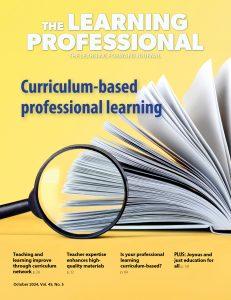Shirley Hord, Learning Forward’s scholar laureate, has focused her career on research about and practice of effective professional learning communities. Here she answers an educator’s question about professional learning communities.
Q: While my school district says it is committed to professional learning communities, I am not sure what they mean by it. We have lots of meetings, but I don’t think things are getting better. What is an authentic professional learning community?
A: I hear this astute observation often. In the U.S., we pride ourselves on being creative and innovative. When a “new” practice appears, everyone is ready to use it. However, with insufficient study of what the innovation is, we implement imprecise or incomplete variations.
Further, in U.S. schools today, the multitude of demands on staff and students precludes sufficient time for clearly identifying and understanding what a specific innovation is, including what a professional learning community is and what role it might play in a school or district.
So, what is an authentic professional learning community?
From my work across the globe with schools targeting school improvement, I believe the professional learning community is the most powerful structure and strategy for enhancing educators’ effectiveness and increasing students’ successful learning. From the research and my own work in the trenches, I posit that:
Improvement requires exchanging what is not working for something that has the potential to do so — this means making a change — and to change requires learning what the change is and how to use it.
The most supportive environment for doing this learning and improvement work is the professional learning community. But what distinguishes an authentic professional learning community from others? What are its attributes or characteristics that rigorous research has revealed to us?
Structural conditions. Time for the communities to meet daily — or weekly at a minimum — uninterrupted in a comfortable space is basic. Paper, electronic, and human resources as well as disaggregated data from multiple sources in easy-to-understand formats must be available.
Supportive relational conditions. Community members’ respect and regard for each other, their conversation styles and interactions, and how they confront conflict all contribute to trust in each other that is essential for a smoothly functioning community.
Shared values and vision. The community’s conversation and actions are grounded in a shared vision of what the school should be about and in alignment with a mental image of newly desired and designated strategies and processes that are implemented effectively.
Intentional collective learning. The professional learning community’s enduring purpose is the continuous learning of the professionals — the educators. The community’s decision about what they will learn and how they will learn it derives from their students’ learning needs.
Peers supporting peers. Community members invite each other to their school or classrooms to observe an identified school or classroom practice of the host member. The visitor observes, takes notes, and conducts a sharing session with the host member. Peers’ visitations provide support as well as assistance to one another in order to operate at their professional peak in service to students.
Shared and supportive leadership. The titled leader of the school, the principal, and the professional learning community members create opportunities for teachers to assume leadership roles and support them in developing the knowledge and skills to do so. Authority and decision making are shared, and, in this way, teachers are given voice and choice. Developing new skills and habits of mind promote the professional learning community members’ feelings of efficacy. They grow in competence and confidence and in developing trust in each other to become true professionals.
These are the six research-based attributes of effective professional learning communities. Engage in reflection about your own professional learning community or your interest in creating one. Identify one or two of the six attributes. What would it take to put these attributes in action in your professional learning community in your school or district? What resources will be needed? Who will be need to be involved? Who can help to develop this attribute? What other factors will you need to address?
Of course, implementing just one or two of the attributes will not make a successful professional learning community, but it is a place to start. I look forward to hearing your reflections.
This post originally appeared in Learning Forward’s PD Watch.





